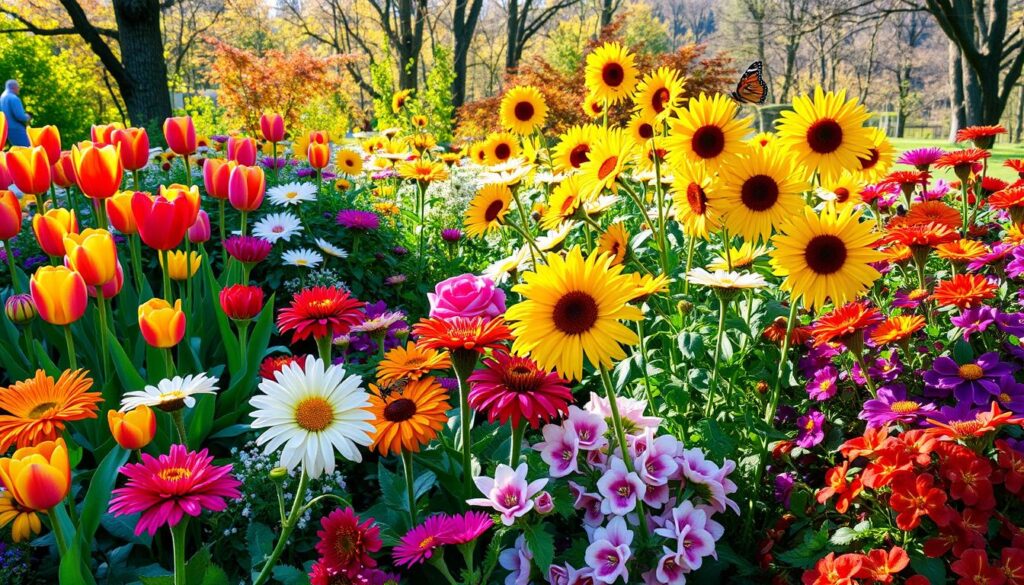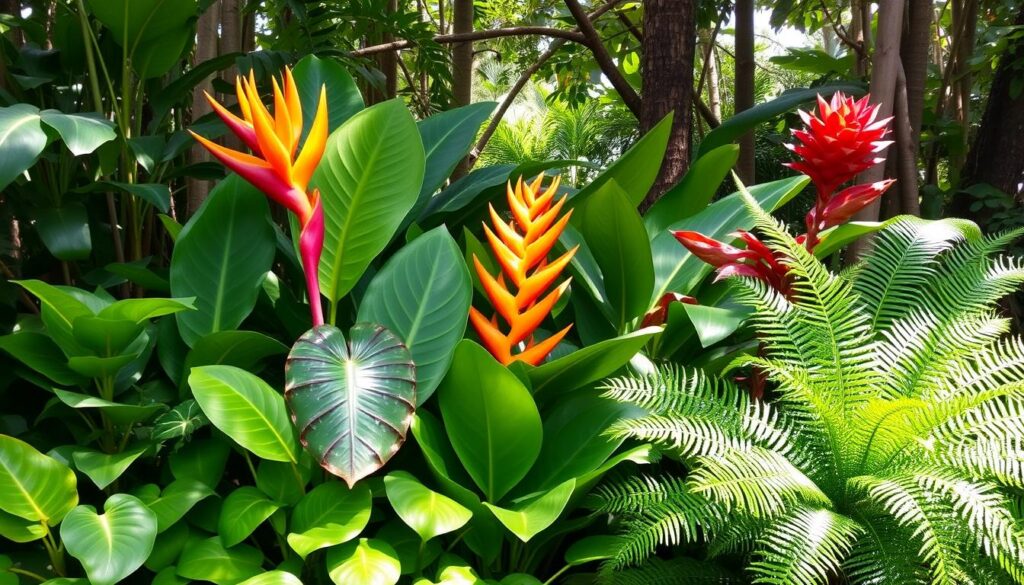How to Protect Your Plants from Intense Heat in the Summer
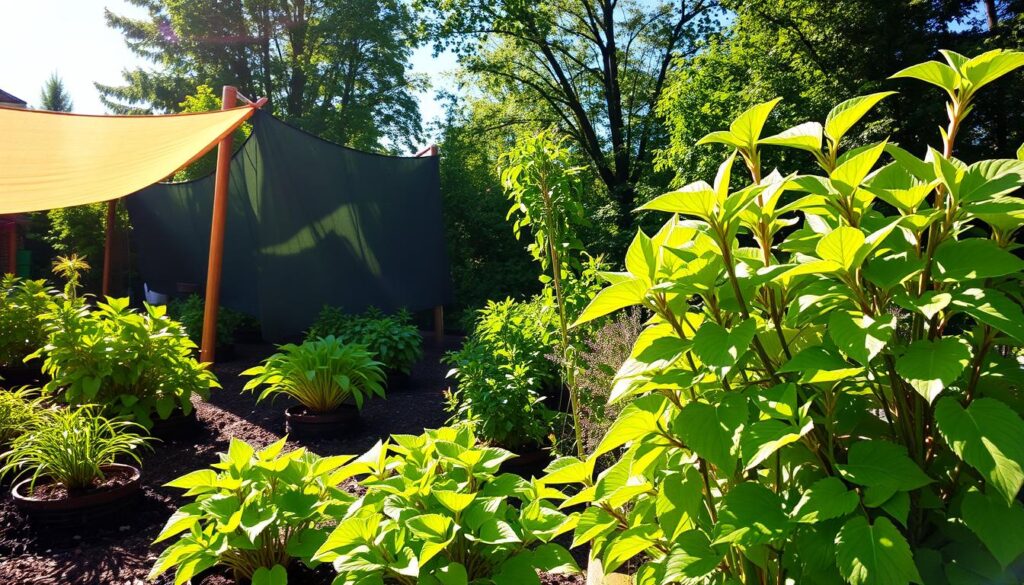
As summer heat arrives, many gardeners worry about their plants. Protecting plants is key, and with the right tips, anyone can help them thrive. Plants can survive and even grow well with the right care.
It’s important to understand how to protect plants in the summer. By following simple tips and precautions, gardeners can keep their plants healthy.
This ensures they can handle the summer heat.
Anyone can be a successful gardener, even in hot summers. By focusing on plant protection and using the best gardening tips, you can have a beautiful garden all year. This is true even with the challenges of summer heat.
Understanding the Effects of Heat on Plants
As summer gets closer, gardeners must watch out for heat stress in their plants. This stress can cause wilting, scorching, and even death. It’s key to know how different plants handle heat. Spotting heat stress signs early helps protect plants from harm.
Not all plants handle heat the same way. Some are more heat-resistant than others. For example, plants with thick, waxy leaves are better at handling heat than those with thin, delicate ones. Choosing the right plants for your garden can help avoid heat stress and keep your outdoor space thriving.
How Heat Affects Different Plant Types
- Plants with deep roots tend to be more resistant to heat stress than those with shallow roots.
- Plants with light-colored leaves or stems can reflect sunlight and heat, reducing the risk of scorching.
- Plants that are native to hot, dry climates tend to be more heat-tolerant than those from cooler, more temperate regions.
Signs of Heat Stress in Plants
It’s important to know the signs of heat stress to act quickly. Look out for wilting, yellowing leaves, and scorching. By watching your plants closely and taking steps to prevent heat stress, you can help them survive and grow well.
Choosing the Right Plants for Hot Weather
When gardening in hot weather, picking the right plants is key. Heat-resistant and native plants are great for summer gardens. They need less care and can handle high temperatures well. This means your garden stays lush and vibrant all season.
Heat-resistant plants can handle high temperatures, need less water, and fight off pests and diseases better. Native plants, having adapted to the local climate, attract native pollinators and need less care. Adding these plants to your garden makes it beautiful and low-maintenance.
Heat-Resistant Plant Varieties
Many heat-resistant plant varieties are available, like succulents, cacti, and drought-tolerant flowers. These plants have evolved to survive in hot, dry conditions. They can make any garden beautiful. Some popular heat-resistant plants include:
- Lantana
- Zinnia
- Marigold
Native Plants and Their Benefits
Native plants are also a great choice for hot weather gardening. They’ve adapted to the local climate and soil, making them perfect for high temperatures. Native plants offer many benefits, such as:
- Attracting native pollinators
- Requiring less maintenance
- Providing a natural source of food and shelter for local wildlife
Proper Watering Techniques for Hot Days
When gardening in hot weather, it’s key to water right. Deep watering helps plants grow strong roots. This makes them better at handling drought. Water them well, then let the soil dry a bit before watering again.
When to water matters too. Watering in the morning is best. It stops fungal diseases that love wet places. Plants drink water all day, cutting down disease risk. Here are some watering tips:
- Water plants deeply, but infrequently, to encourage deep root growth
- Water early in the day to prevent fungal diseases
- Check the soil moisture before watering to avoid overwatering
Follow these tips and your plants will do great, even when it’s very hot.
Importance of Deep Watering
Deep watering is a simple yet powerful method. It helps plants grow strong roots. This makes them more drought-resistant and resilient to stress.
Watering Early vs. Late in the Day
Watering in the morning is better than at night. Plants absorb water all day, reducing disease risk. Early watering keeps plants healthy and strong, even in the heat.
Creating Shade for Vulnerable Plants
Shade is key to protect plants from too much sunlight, especially in summer. You can use shade cloths or natural shade to help. This keeps plants healthy and prevents heat stress.
Shade cloths are a simple way to block sunlight. They come in different densities for various plants. You can also use trees or structures to create shade naturally.
Using Shade Cloths Effectively
When using shade cloths, think about your plants’ needs. Lighter cloths work for full sun plants, while denser ones are better for partial shade. You can hang them on frames or trellises to cover different parts of your garden.
Natural Shade Solutions: Trees and Structures
Planting trees or using structures like gazebos can offer lasting shade. These natural solutions add beauty to your garden. Combining them with shade cloths gives your plants the best protection.
Benefits of natural shade include:
- Reduced heat stress for plants
- Promoted healthier plant growth
- Increased biodiversity in the garden
- Aesthetic value added to the garden
Improving Soil Quality for Heat Protection
Soil quality is key to protecting plants from heat stress. Gardeners can make their gardens more resilient by improving soil quality. This can be done by mulching and adding organic amendments.
Mulching keeps moisture in, fights weeds, and controls soil temperature. Organic amendments make soil hold water better, so plants don’t need to be watered as often.
Improving soil quality has many benefits:
- It helps plants hold water, so they don’t need to be watered as much.
- It makes plants more heat-tolerant, so they can thrive in hot weather.
- It helps plants absorb nutrients better, leading to healthier growth.
Importance of Mulching
Mulching is a simple yet effective way to improve soil quality. By adding a layer of organic mulch, like wood chips or straw, you can keep moisture in. This also helps fight weeds and control soil temperature.
This reduces stress on plants, letting them focus on growing and developing.
Organic Amendments for Water Retention
Organic amendments, like compost or manure, boost soil’s water-holding capacity. Adding these helps reduce the need for frequent watering. This makes your garden more sustainable and resilient.
It also supports healthy microbial activity, which is good for plant health and well-being.
| Amendment | Benefits |
|---|---|
| Compost | Improves soil structure, increases water-holding capacity |
| Manure | Provides nutrients, supports microbial activity |
Using Irrigation Systems Wisely
Gardeners aim to give plants just the right amount of water. Irrigation systems help by sending water straight to the roots. This cuts down on evaporation and runoff.
Using these systems smartly helps save water. It’s all about giving plants what they need without wasting a drop.
Drip irrigation is a top choice for gardeners. It keeps water flowing steadily to the plants. This method lowers the chance of too much or too little water.
To make drip irrigation work best, create a watering schedule. Consider the weather and how wet the soil is.
Benefits of Drip Irrigation
- Reduces water waste through evaporation and runoff
- Provides a consistent supply of water to plants
- Helps prevent overwatering and underwatering
Adding irrigation systems to your gardening routine is smart. It leads to healthier plants and better water use. Keep an eye on your watering schedule and tweak it as needed for the best results.
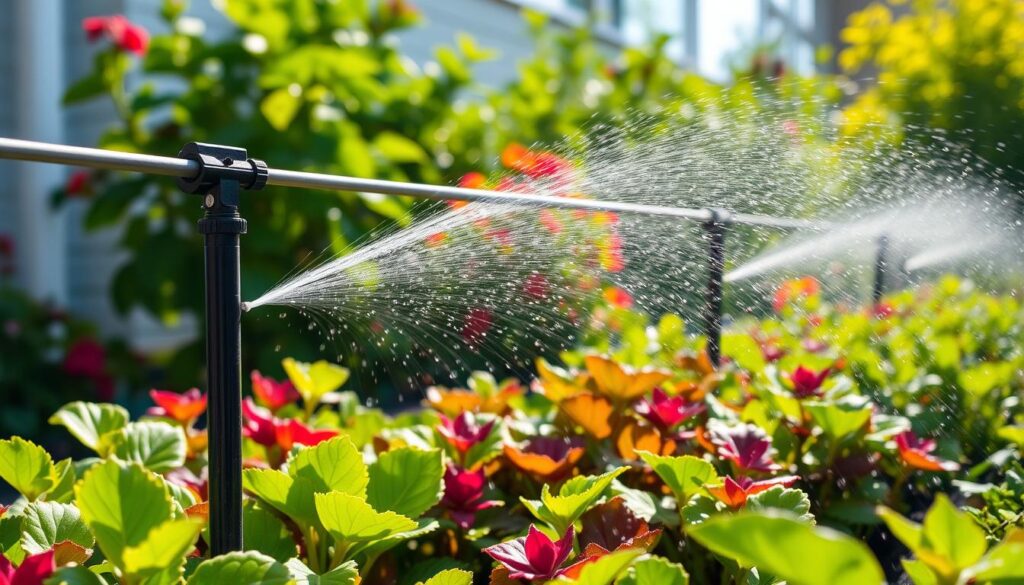
Keeping Plants Hydrated with Strategies
In the hot summer, it’s key to keep plants watered. Soaking their roots in water is a good way to do this. It helps plants stay moist, especially those that dry out quickly.
Plant grouping is another smart move. It makes a mini-weather zone around plants. This zone keeps moisture in, cutting down on the need to water often. It’s great for plants that don’t like dry air.
Effective Soaking Techniques
- Soak plant roots in water for 10-15 minutes to replenish moisture
- Use a well-draining potting mix to prevent waterlogged soil
- Monitor soil moisture levels to avoid overwatering
Benefits of Plant Grouping
Plant grouping has many perks. It lowers evaporation, keeps soil moist, and boosts plant health. It turns your garden into a lush, thriving space. Plus, it’s good for the planet since it cuts down on water waste.
| Plant Grouping Benefits | Description |
|---|---|
| Reduced Evaporation | Grouping plants together reduces evaporation, minimizing the need for frequent watering |
| Improved Soil Moisture | Plant grouping helps maintain soil moisture levels, supporting healthy plant growth |
| Enhanced Plant Growth | By creating a thriving ecosystem, plant grouping promotes healthy plant growth and development |
Monitoring and Adjusting Fertilization
As plants grow, they need essential nutrients to thrive. In the summer, fertilization is key for healthy growth. Heat can slow down nutrient uptake, so it’s important to keep an eye on and tweak fertilization plans.
Summer fertilizers are made to help plants handle heat. They support growth, increase yields, and make plants more resilient. Important things to think about with summer fertilizers include:
- Slow-release formulas to provide sustained nutrient delivery
- Water-soluble options for efficient absorption
- Organic alternatives to minimize environmental impact
By tweaking fertilization and using summer fertilizers, gardeners can help their plants do well in the heat. It’s vital to know how heat affects nutrient uptake and pick the best fertilizer for healthy growth.
Protecting Potted Plants from Heat
Potted plants face a big challenge in the heat because their roots are cramped. To help, gardeners can take a few steps. One important thing is container placement. Putting plants in shaded spots or windy balconies can lower heat stress.
Another key point is pot insulation. Using materials like straw or foam can keep the temperature steady. This is vital for plants that can’t handle extreme heat.
Ideal Placement for Containers
Choosing the right spot for container placement is crucial. For example, plants near water or with good air flow stay cooler. Also, pot insulation helps block heat and keeps the soil cool.
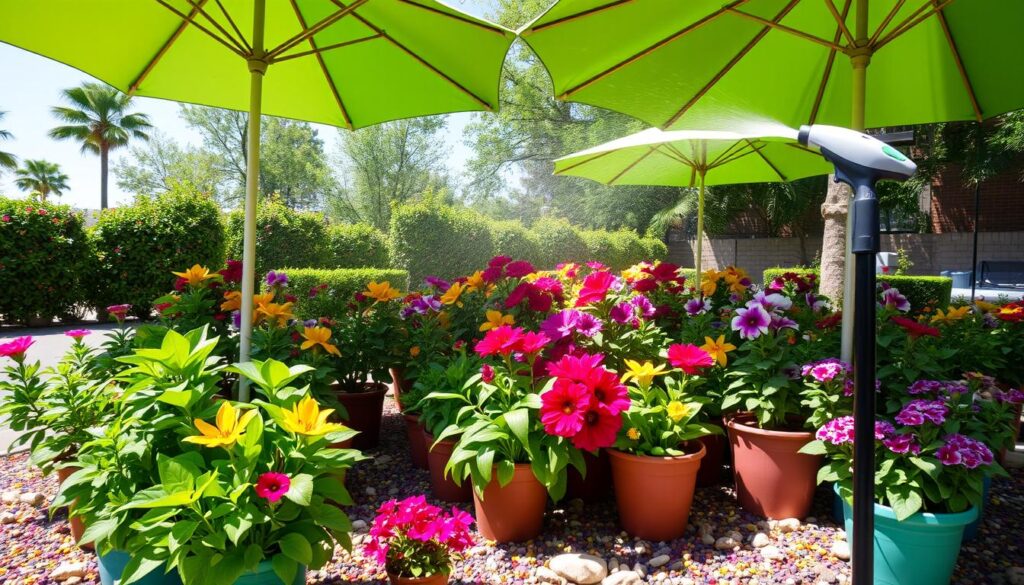
Insulating Pots for Temperature Control
There are many ways to insulate pots, like using straw, foam, or reflective tape. Wrapping these around the pot reflects heat and keeps soil cool. This is key for potted plants in direct sunlight.
Here are some tips to protect potted plants from heat:
- Use light-colored pots to reflect heat
- Water plants in the early morning or evening to avoid losing water
- Give plants shade during the hottest part of the day
By using these tips and thinking about container placement and pot insulation, gardeners can shield their potted plants from summer’s heat.
Adjusting Garden Layout for Heat Protection
Adjusting the garden layout is key to protecting plants from heat. By planning carefully, gardeners can make their gardens more resilient. They should think about the size, growth, and heat tolerance of each plant.
A good garden layout can lessen heat’s impact on plants. For example, plant placement is very important. Taller plants can shade smaller ones, reducing sunlight. This works well with companion planting, where plants help each other out.
Strategic Plant Placement
To make a heat-resistant garden, follow these tips:
- Put taller plants on the south or west to shade smaller ones.
- Use plants with wide leaves or dense foliage to cool the soil.
- Group plants with similar heat tolerance together for better growth.
Companion Planting Benefits
Companion planting boosts garden health and resilience. By picking plants that help each other, gardens become more diverse and strong. For instance, marigolds with tomatoes fight nematodes, and basil with peppers improves flavor.
A garden that uses companion planting and smart plant placement will be beautiful and strong, even in hot weather.
Preparing for Heat Waves in Advance
As summer gets hotter, gardeners must act fast to protect their plants. Recognizing early signs of a heat wave is key. These signs include rising temperatures and lower humidity.
Signs of an Imminent Heat Wave
Watch the weather closely and look out for heat wave alerts. A sudden rise in temperature and a drop in humidity are big clues. These signs mean a heat wave is coming.
Emergency Measures for Extreme Conditions
When a heat wave hits, your plants need extra care. Increase watering, add shade cloth, or move plants to safer spots. These steps help your garden stay healthy and strong until the heat goes away.
